Professional Communication for Nurses
VerifiedAdded on 2020/02/03
|12
|3074
|279
Report
AI Summary
This assignment focuses on professional communication skills essential for nurses. It delves into various aspects of effective communication in healthcare settings, including interacting with patients, collaborating with colleagues, and utilizing clear and concise language. The provided resources explore the importance of communication skills training for nurses and offer insights into best practices for fostering positive patient-centered care.
Contribute Materials
Your contribution can guide someone’s learning journey. Share your
documents today.
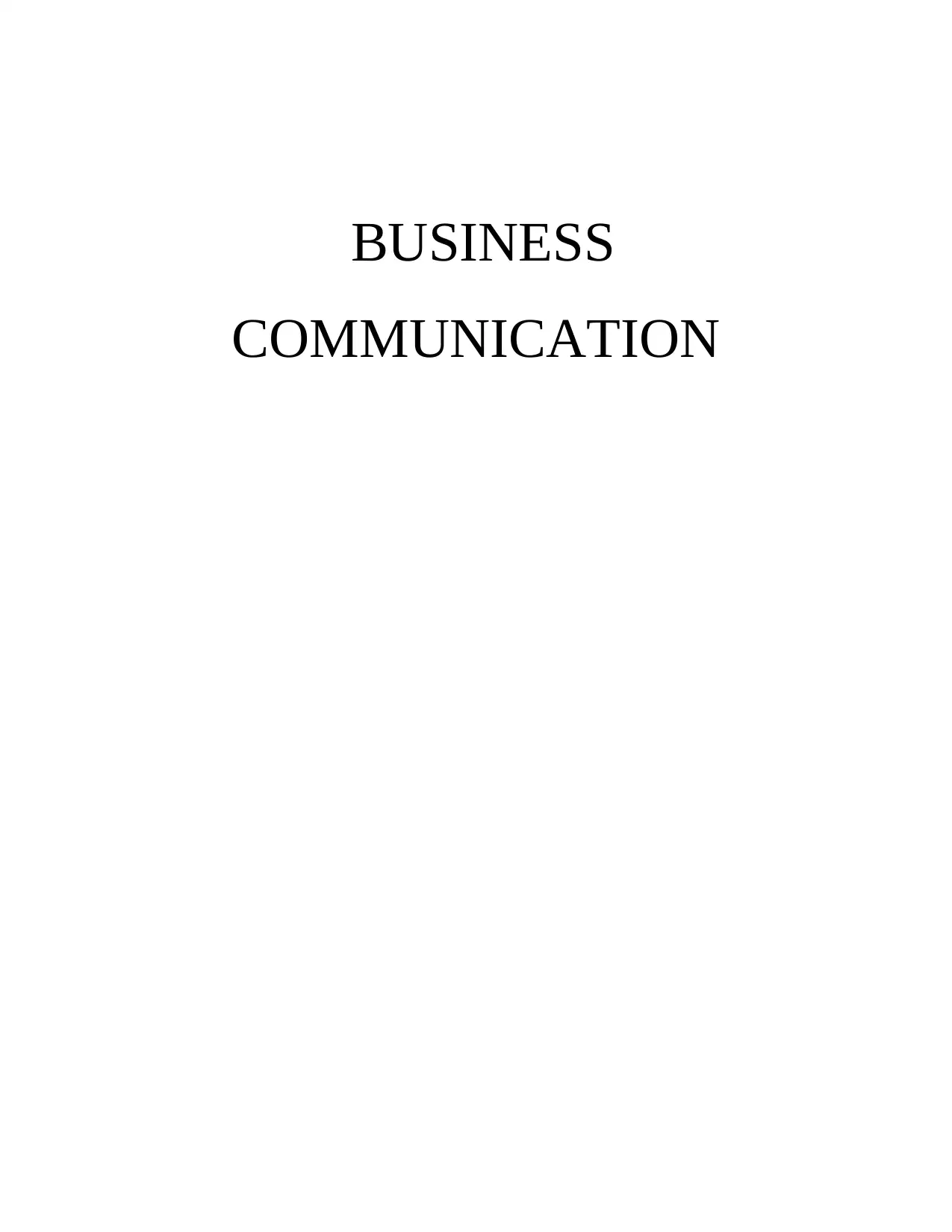
BUSINESS
COMMUNICATION
COMMUNICATION
Secure Best Marks with AI Grader
Need help grading? Try our AI Grader for instant feedback on your assignments.
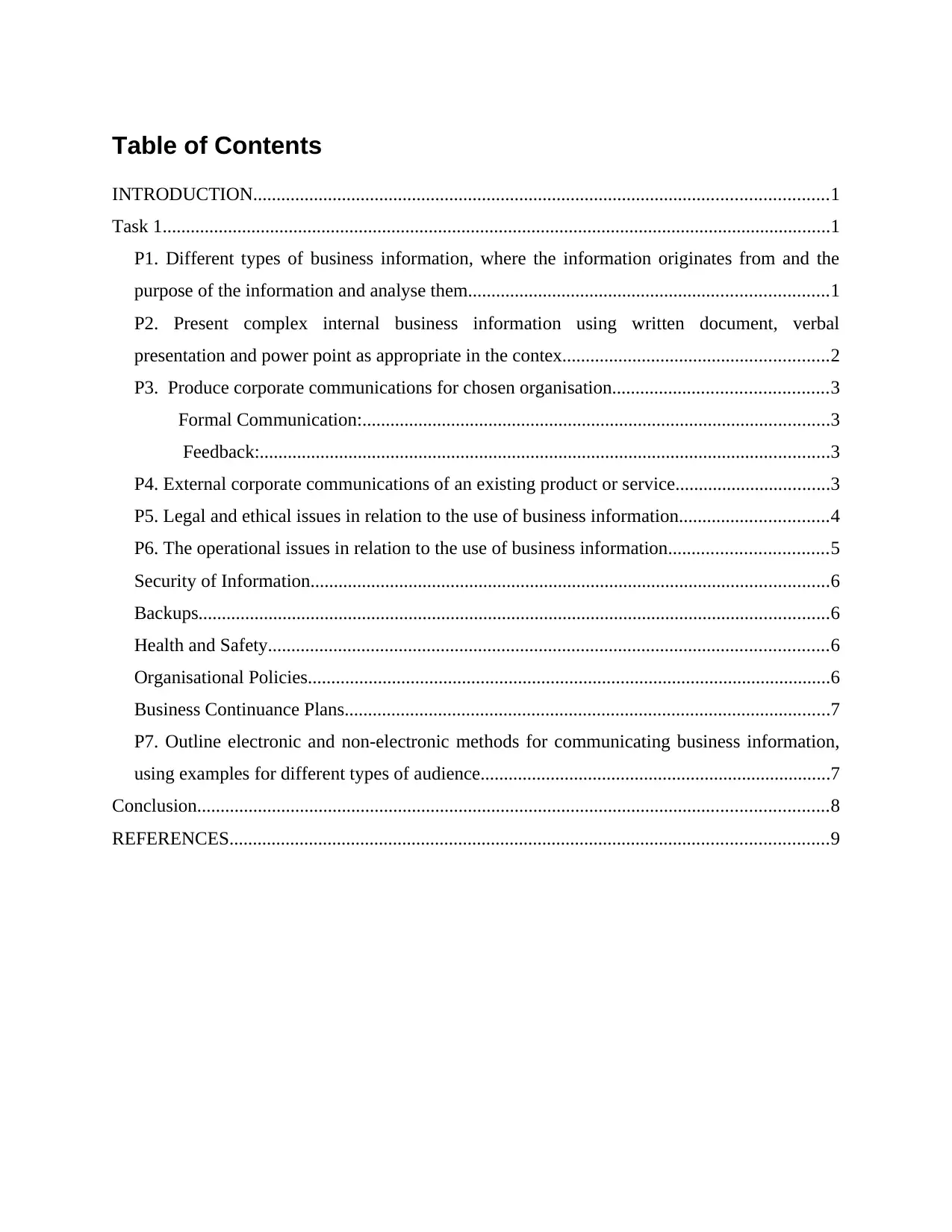
Table of Contents
INTRODUCTION...........................................................................................................................1
Task 1...............................................................................................................................................1
P1. Different types of business information, where the information originates from and the
purpose of the information and analyse them.............................................................................1
P2. Present complex internal business information using written document, verbal
presentation and power point as appropriate in the contex.........................................................2
P3. Produce corporate communications for chosen organisation..............................................3
Formal Communication:....................................................................................................3
Feedback:..........................................................................................................................3
P4. External corporate communications of an existing product or service.................................3
P5. Legal and ethical issues in relation to the use of business information................................4
P6. The operational issues in relation to the use of business information..................................5
Security of Information...............................................................................................................6
Backups.......................................................................................................................................6
Health and Safety........................................................................................................................6
Organisational Policies................................................................................................................6
Business Continuance Plans........................................................................................................7
P7. Outline electronic and non-electronic methods for communicating business information,
using examples for different types of audience...........................................................................7
Conclusion.......................................................................................................................................8
REFERENCES................................................................................................................................9
INTRODUCTION...........................................................................................................................1
Task 1...............................................................................................................................................1
P1. Different types of business information, where the information originates from and the
purpose of the information and analyse them.............................................................................1
P2. Present complex internal business information using written document, verbal
presentation and power point as appropriate in the contex.........................................................2
P3. Produce corporate communications for chosen organisation..............................................3
Formal Communication:....................................................................................................3
Feedback:..........................................................................................................................3
P4. External corporate communications of an existing product or service.................................3
P5. Legal and ethical issues in relation to the use of business information................................4
P6. The operational issues in relation to the use of business information..................................5
Security of Information...............................................................................................................6
Backups.......................................................................................................................................6
Health and Safety........................................................................................................................6
Organisational Policies................................................................................................................6
Business Continuance Plans........................................................................................................7
P7. Outline electronic and non-electronic methods for communicating business information,
using examples for different types of audience...........................................................................7
Conclusion.......................................................................................................................................8
REFERENCES................................................................................................................................9
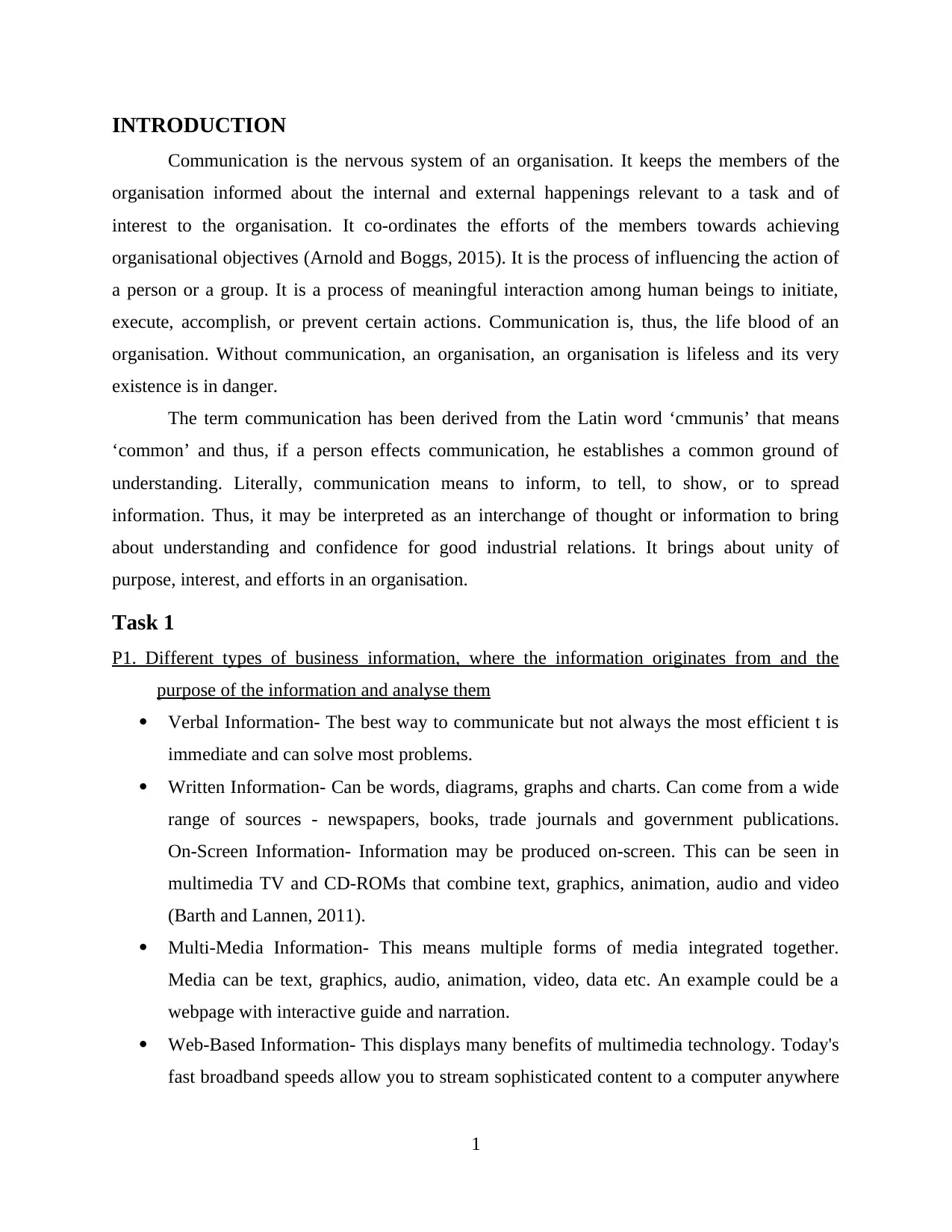
INTRODUCTION
Communication is the nervous system of an organisation. It keeps the members of the
organisation informed about the internal and external happenings relevant to a task and of
interest to the organisation. It co-ordinates the efforts of the members towards achieving
organisational objectives (Arnold and Boggs, 2015). It is the process of influencing the action of
a person or a group. It is a process of meaningful interaction among human beings to initiate,
execute, accomplish, or prevent certain actions. Communication is, thus, the life blood of an
organisation. Without communication, an organisation, an organisation is lifeless and its very
existence is in danger.
The term communication has been derived from the Latin word ‘cmmunis’ that means
‘common’ and thus, if a person effects communication, he establishes a common ground of
understanding. Literally, communication means to inform, to tell, to show, or to spread
information. Thus, it may be interpreted as an interchange of thought or information to bring
about understanding and confidence for good industrial relations. It brings about unity of
purpose, interest, and efforts in an organisation.
Task 1
P1. Different types of business information, where the information originates from and the
purpose of the information and analyse them
Verbal Information- The best way to communicate but not always the most efficient t is
immediate and can solve most problems.
Written Information- Can be words, diagrams, graphs and charts. Can come from a wide
range of sources - newspapers, books, trade journals and government publications.
On-Screen Information- Information may be produced on-screen. This can be seen in
multimedia TV and CD-ROMs that combine text, graphics, animation, audio and video
(Barth and Lannen, 2011).
Multi-Media Information- This means multiple forms of media integrated together.
Media can be text, graphics, audio, animation, video, data etc. An example could be a
webpage with interactive guide and narration.
Web-Based Information- This displays many benefits of multimedia technology. Today's
fast broadband speeds allow you to stream sophisticated content to a computer anywhere
1
Communication is the nervous system of an organisation. It keeps the members of the
organisation informed about the internal and external happenings relevant to a task and of
interest to the organisation. It co-ordinates the efforts of the members towards achieving
organisational objectives (Arnold and Boggs, 2015). It is the process of influencing the action of
a person or a group. It is a process of meaningful interaction among human beings to initiate,
execute, accomplish, or prevent certain actions. Communication is, thus, the life blood of an
organisation. Without communication, an organisation, an organisation is lifeless and its very
existence is in danger.
The term communication has been derived from the Latin word ‘cmmunis’ that means
‘common’ and thus, if a person effects communication, he establishes a common ground of
understanding. Literally, communication means to inform, to tell, to show, or to spread
information. Thus, it may be interpreted as an interchange of thought or information to bring
about understanding and confidence for good industrial relations. It brings about unity of
purpose, interest, and efforts in an organisation.
Task 1
P1. Different types of business information, where the information originates from and the
purpose of the information and analyse them
Verbal Information- The best way to communicate but not always the most efficient t is
immediate and can solve most problems.
Written Information- Can be words, diagrams, graphs and charts. Can come from a wide
range of sources - newspapers, books, trade journals and government publications.
On-Screen Information- Information may be produced on-screen. This can be seen in
multimedia TV and CD-ROMs that combine text, graphics, animation, audio and video
(Barth and Lannen, 2011).
Multi-Media Information- This means multiple forms of media integrated together.
Media can be text, graphics, audio, animation, video, data etc. An example could be a
webpage with interactive guide and narration.
Web-Based Information- This displays many benefits of multimedia technology. Today's
fast broadband speeds allow you to stream sophisticated content to a computer anywhere
1
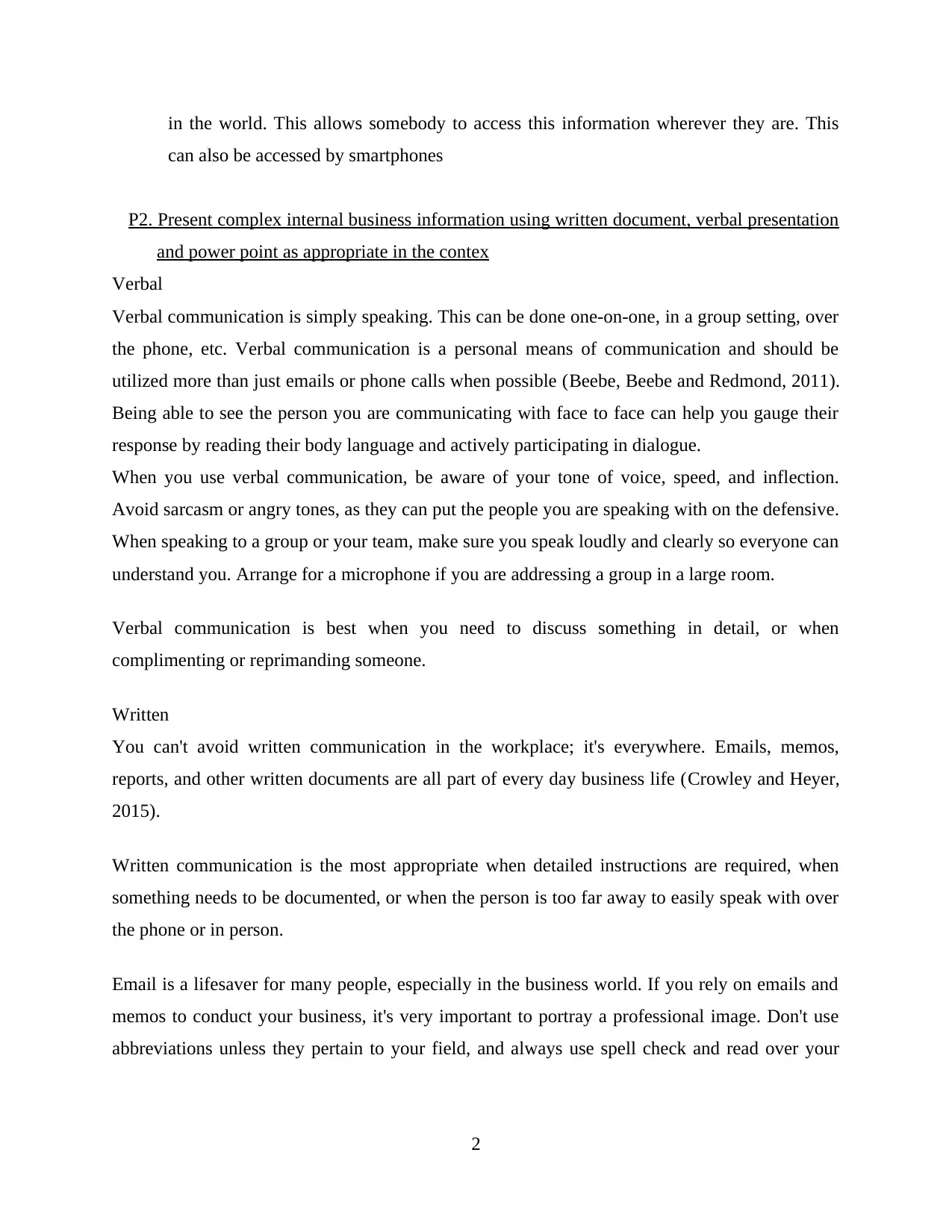
in the world. This allows somebody to access this information wherever they are. This
can also be accessed by smartphones
P2. Present complex internal business information using written document, verbal presentation
and power point as appropriate in the contex
Verbal
Verbal communication is simply speaking. This can be done one-on-one, in a group setting, over
the phone, etc. Verbal communication is a personal means of communication and should be
utilized more than just emails or phone calls when possible (Beebe, Beebe and Redmond, 2011).
Being able to see the person you are communicating with face to face can help you gauge their
response by reading their body language and actively participating in dialogue.
When you use verbal communication, be aware of your tone of voice, speed, and inflection.
Avoid sarcasm or angry tones, as they can put the people you are speaking with on the defensive.
When speaking to a group or your team, make sure you speak loudly and clearly so everyone can
understand you. Arrange for a microphone if you are addressing a group in a large room.
Verbal communication is best when you need to discuss something in detail, or when
complimenting or reprimanding someone.
Written
You can't avoid written communication in the workplace; it's everywhere. Emails, memos,
reports, and other written documents are all part of every day business life (Crowley and Heyer,
2015).
Written communication is the most appropriate when detailed instructions are required, when
something needs to be documented, or when the person is too far away to easily speak with over
the phone or in person.
Email is a lifesaver for many people, especially in the business world. If you rely on emails and
memos to conduct your business, it's very important to portray a professional image. Don't use
abbreviations unless they pertain to your field, and always use spell check and read over your
2
can also be accessed by smartphones
P2. Present complex internal business information using written document, verbal presentation
and power point as appropriate in the contex
Verbal
Verbal communication is simply speaking. This can be done one-on-one, in a group setting, over
the phone, etc. Verbal communication is a personal means of communication and should be
utilized more than just emails or phone calls when possible (Beebe, Beebe and Redmond, 2011).
Being able to see the person you are communicating with face to face can help you gauge their
response by reading their body language and actively participating in dialogue.
When you use verbal communication, be aware of your tone of voice, speed, and inflection.
Avoid sarcasm or angry tones, as they can put the people you are speaking with on the defensive.
When speaking to a group or your team, make sure you speak loudly and clearly so everyone can
understand you. Arrange for a microphone if you are addressing a group in a large room.
Verbal communication is best when you need to discuss something in detail, or when
complimenting or reprimanding someone.
Written
You can't avoid written communication in the workplace; it's everywhere. Emails, memos,
reports, and other written documents are all part of every day business life (Crowley and Heyer,
2015).
Written communication is the most appropriate when detailed instructions are required, when
something needs to be documented, or when the person is too far away to easily speak with over
the phone or in person.
Email is a lifesaver for many people, especially in the business world. If you rely on emails and
memos to conduct your business, it's very important to portray a professional image. Don't use
abbreviations unless they pertain to your field, and always use spell check and read over your
2
Secure Best Marks with AI Grader
Need help grading? Try our AI Grader for instant feedback on your assignments.
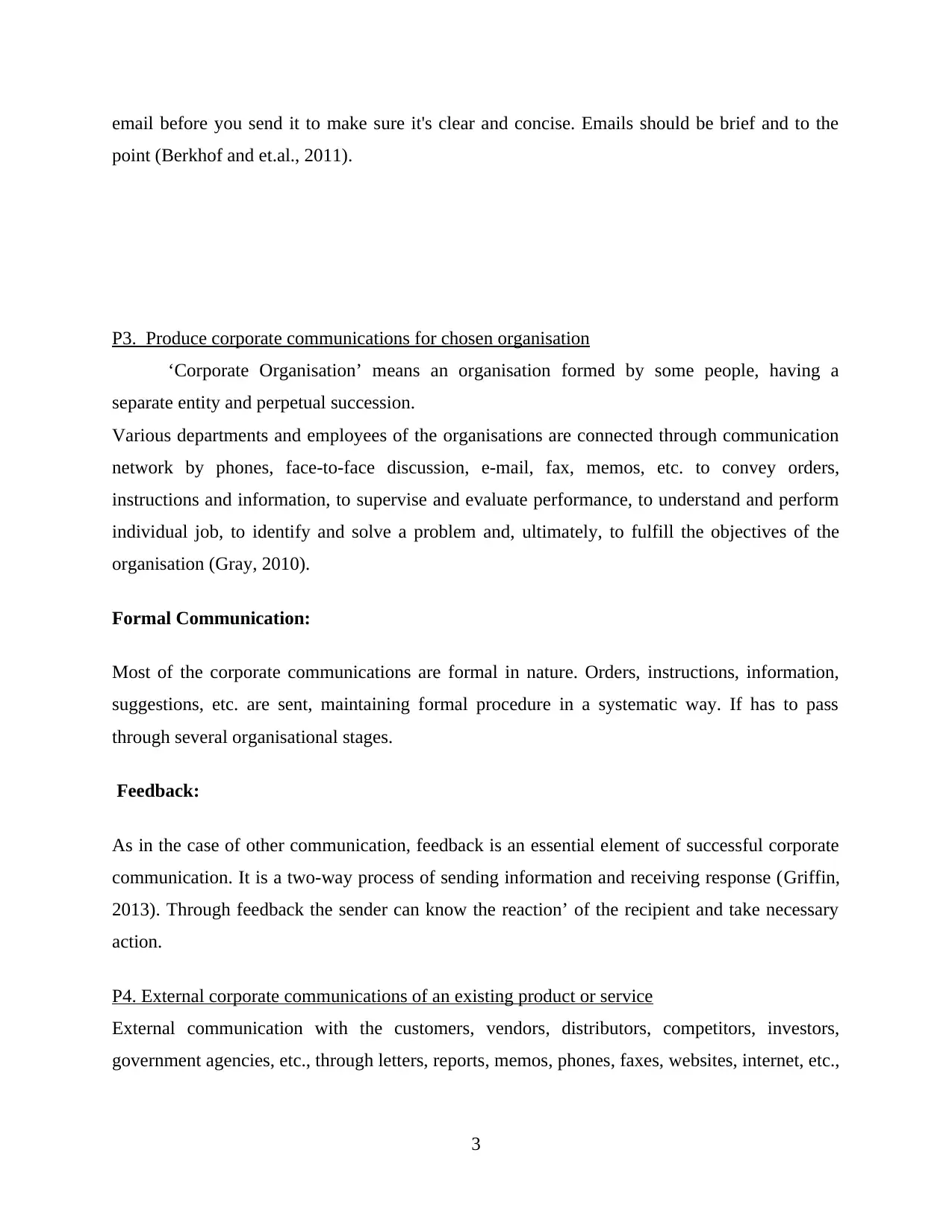
email before you send it to make sure it's clear and concise. Emails should be brief and to the
point (Berkhof and et.al., 2011).
P3. Produce corporate communications for chosen organisation
‘Corporate Organisation’ means an organisation formed by some people, having a
separate entity and perpetual succession.
Various departments and employees of the organisations are connected through communication
network by phones, face-to-face discussion, e-mail, fax, memos, etc. to convey orders,
instructions and information, to supervise and evaluate performance, to understand and perform
individual job, to identify and solve a problem and, ultimately, to fulfill the objectives of the
organisation (Gray, 2010).
Formal Communication:
Most of the corporate communications are formal in nature. Orders, instructions, information,
suggestions, etc. are sent, maintaining formal procedure in a systematic way. If has to pass
through several organisational stages.
Feedback:
As in the case of other communication, feedback is an essential element of successful corporate
communication. It is a two-way process of sending information and receiving response (Griffin,
2013). Through feedback the sender can know the reaction’ of the recipient and take necessary
action.
P4. External corporate communications of an existing product or service
External communication with the customers, vendors, distributors, competitors, investors,
government agencies, etc., through letters, reports, memos, phones, faxes, websites, internet, etc.,
3
point (Berkhof and et.al., 2011).
P3. Produce corporate communications for chosen organisation
‘Corporate Organisation’ means an organisation formed by some people, having a
separate entity and perpetual succession.
Various departments and employees of the organisations are connected through communication
network by phones, face-to-face discussion, e-mail, fax, memos, etc. to convey orders,
instructions and information, to supervise and evaluate performance, to understand and perform
individual job, to identify and solve a problem and, ultimately, to fulfill the objectives of the
organisation (Gray, 2010).
Formal Communication:
Most of the corporate communications are formal in nature. Orders, instructions, information,
suggestions, etc. are sent, maintaining formal procedure in a systematic way. If has to pass
through several organisational stages.
Feedback:
As in the case of other communication, feedback is an essential element of successful corporate
communication. It is a two-way process of sending information and receiving response (Griffin,
2013). Through feedback the sender can know the reaction’ of the recipient and take necessary
action.
P4. External corporate communications of an existing product or service
External communication with the customers, vendors, distributors, competitors, investors,
government agencies, etc., through letters, reports, memos, phones, faxes, websites, internet, etc.,
3

are made to introduce, negotiate, co-ordinate, explain, interact, discuss and to develop co-
operation and understanding.
Therefore, corporate communication refers to a process of communication through which the
managers, supervisors and executives exchange their views, opinions, feelings, etc. with the
subordinates and employees in any corporate organisation and negotiate with the outside world
with a view to fulfilling the objectives of the organisation (Guffey and Loewy, 2010).
P5. Legal and ethical issues in relation to the use of business information
This task I’m going to explain the legal and ethical issues in relation to the use of
businesses information and also I’m going to explain operational issues as well in the last park of
the task i going to analyse the legal ethical and operational issues using appropriate examples .
Most people do not feel safe in putting or giving their personal details on different social
networks like Facebook and Twitter and another organization who uses the personal detail from
the people or customers , the reason being of many hackers invading other people's privacy this
also can happen with many businesses as well such as Tesco, Asda e.g. if they do not have a
security (Hargie, Boohan and Murphy, 2010).
his is a law in the UK that legislates against certain activities using computers, such as hacking
into other people's systems, misusing software or helping a person to gain access to protected
files on someone else's computer. It is split into 3 sections and makes illegal:
Unauthorised access to computer material✓
Unauthorised access to computer systems with intent to commit another offence✓
Unauthorised modification of computer material✓
Ethical Issues
Business ethics are moral principles concerning acceptable and unacceptable behavior by
businesses. Codes of practice exist in organisations to maintain business ethics on:
4
operation and understanding.
Therefore, corporate communication refers to a process of communication through which the
managers, supervisors and executives exchange their views, opinions, feelings, etc. with the
subordinates and employees in any corporate organisation and negotiate with the outside world
with a view to fulfilling the objectives of the organisation (Guffey and Loewy, 2010).
P5. Legal and ethical issues in relation to the use of business information
This task I’m going to explain the legal and ethical issues in relation to the use of
businesses information and also I’m going to explain operational issues as well in the last park of
the task i going to analyse the legal ethical and operational issues using appropriate examples .
Most people do not feel safe in putting or giving their personal details on different social
networks like Facebook and Twitter and another organization who uses the personal detail from
the people or customers , the reason being of many hackers invading other people's privacy this
also can happen with many businesses as well such as Tesco, Asda e.g. if they do not have a
security (Hargie, Boohan and Murphy, 2010).
his is a law in the UK that legislates against certain activities using computers, such as hacking
into other people's systems, misusing software or helping a person to gain access to protected
files on someone else's computer. It is split into 3 sections and makes illegal:
Unauthorised access to computer material✓
Unauthorised access to computer systems with intent to commit another offence✓
Unauthorised modification of computer material✓
Ethical Issues
Business ethics are moral principles concerning acceptable and unacceptable behavior by
businesses. Codes of practice exist in organisations to maintain business ethics on:
4
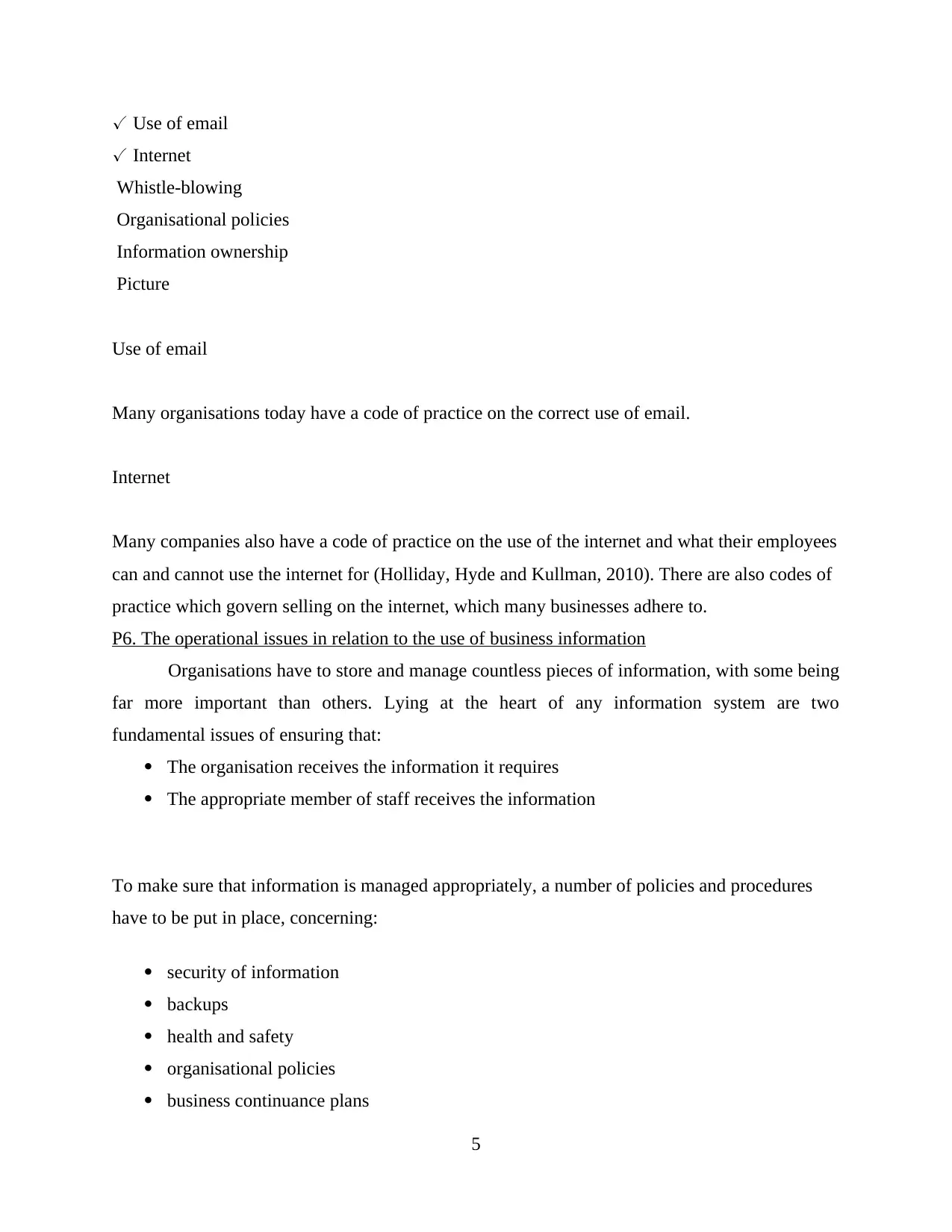
Use of email✓
Internet✓
Whistle-blowing
Organisational policies
Information ownership
Picture
Use of email
Many organisations today have a code of practice on the correct use of email.
Internet
Many companies also have a code of practice on the use of the internet and what their employees
can and cannot use the internet for (Holliday, Hyde and Kullman, 2010). There are also codes of
practice which govern selling on the internet, which many businesses adhere to.
P6. The operational issues in relation to the use of business information
Organisations have to store and manage countless pieces of information, with some being
far more important than others. Lying at the heart of any information system are two
fundamental issues of ensuring that:
The organisation receives the information it requires
The appropriate member of staff receives the information
To make sure that information is managed appropriately, a number of policies and procedures
have to be put in place, concerning:
security of information
backups
health and safety
organisational policies
business continuance plans
5
Internet✓
Whistle-blowing
Organisational policies
Information ownership
Picture
Use of email
Many organisations today have a code of practice on the correct use of email.
Internet
Many companies also have a code of practice on the use of the internet and what their employees
can and cannot use the internet for (Holliday, Hyde and Kullman, 2010). There are also codes of
practice which govern selling on the internet, which many businesses adhere to.
P6. The operational issues in relation to the use of business information
Organisations have to store and manage countless pieces of information, with some being
far more important than others. Lying at the heart of any information system are two
fundamental issues of ensuring that:
The organisation receives the information it requires
The appropriate member of staff receives the information
To make sure that information is managed appropriately, a number of policies and procedures
have to be put in place, concerning:
security of information
backups
health and safety
organisational policies
business continuance plans
5
Paraphrase This Document
Need a fresh take? Get an instant paraphrase of this document with our AI Paraphraser
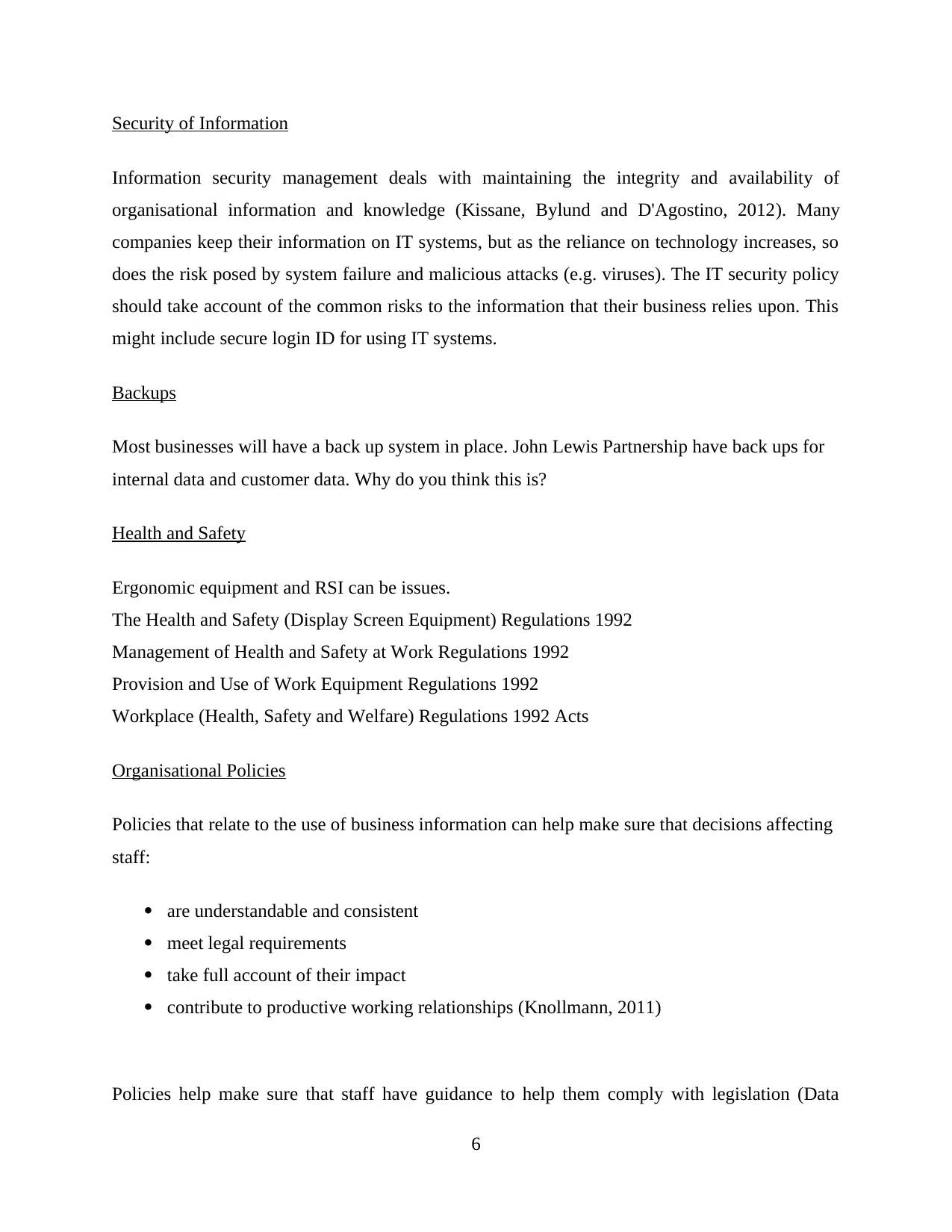
Security of Information
Information security management deals with maintaining the integrity and availability of
organisational information and knowledge (Kissane, Bylund and D'Agostino, 2012). Many
companies keep their information on IT systems, but as the reliance on technology increases, so
does the risk posed by system failure and malicious attacks (e.g. viruses). The IT security policy
should take account of the common risks to the information that their business relies upon. This
might include secure login ID for using IT systems.
Backups
Most businesses will have a back up system in place. John Lewis Partnership have back ups for
internal data and customer data. Why do you think this is?
Health and Safety
Ergonomic equipment and RSI can be issues.
The Health and Safety (Display Screen Equipment) Regulations 1992
Management of Health and Safety at Work Regulations 1992
Provision and Use of Work Equipment Regulations 1992
Workplace (Health, Safety and Welfare) Regulations 1992 Acts
Organisational Policies
Policies that relate to the use of business information can help make sure that decisions affecting
staff:
are understandable and consistent
meet legal requirements
take full account of their impact
contribute to productive working relationships (Knollmann, 2011)
Policies help make sure that staff have guidance to help them comply with legislation (Data
6
Information security management deals with maintaining the integrity and availability of
organisational information and knowledge (Kissane, Bylund and D'Agostino, 2012). Many
companies keep their information on IT systems, but as the reliance on technology increases, so
does the risk posed by system failure and malicious attacks (e.g. viruses). The IT security policy
should take account of the common risks to the information that their business relies upon. This
might include secure login ID for using IT systems.
Backups
Most businesses will have a back up system in place. John Lewis Partnership have back ups for
internal data and customer data. Why do you think this is?
Health and Safety
Ergonomic equipment and RSI can be issues.
The Health and Safety (Display Screen Equipment) Regulations 1992
Management of Health and Safety at Work Regulations 1992
Provision and Use of Work Equipment Regulations 1992
Workplace (Health, Safety and Welfare) Regulations 1992 Acts
Organisational Policies
Policies that relate to the use of business information can help make sure that decisions affecting
staff:
are understandable and consistent
meet legal requirements
take full account of their impact
contribute to productive working relationships (Knollmann, 2011)
Policies help make sure that staff have guidance to help them comply with legislation (Data
6
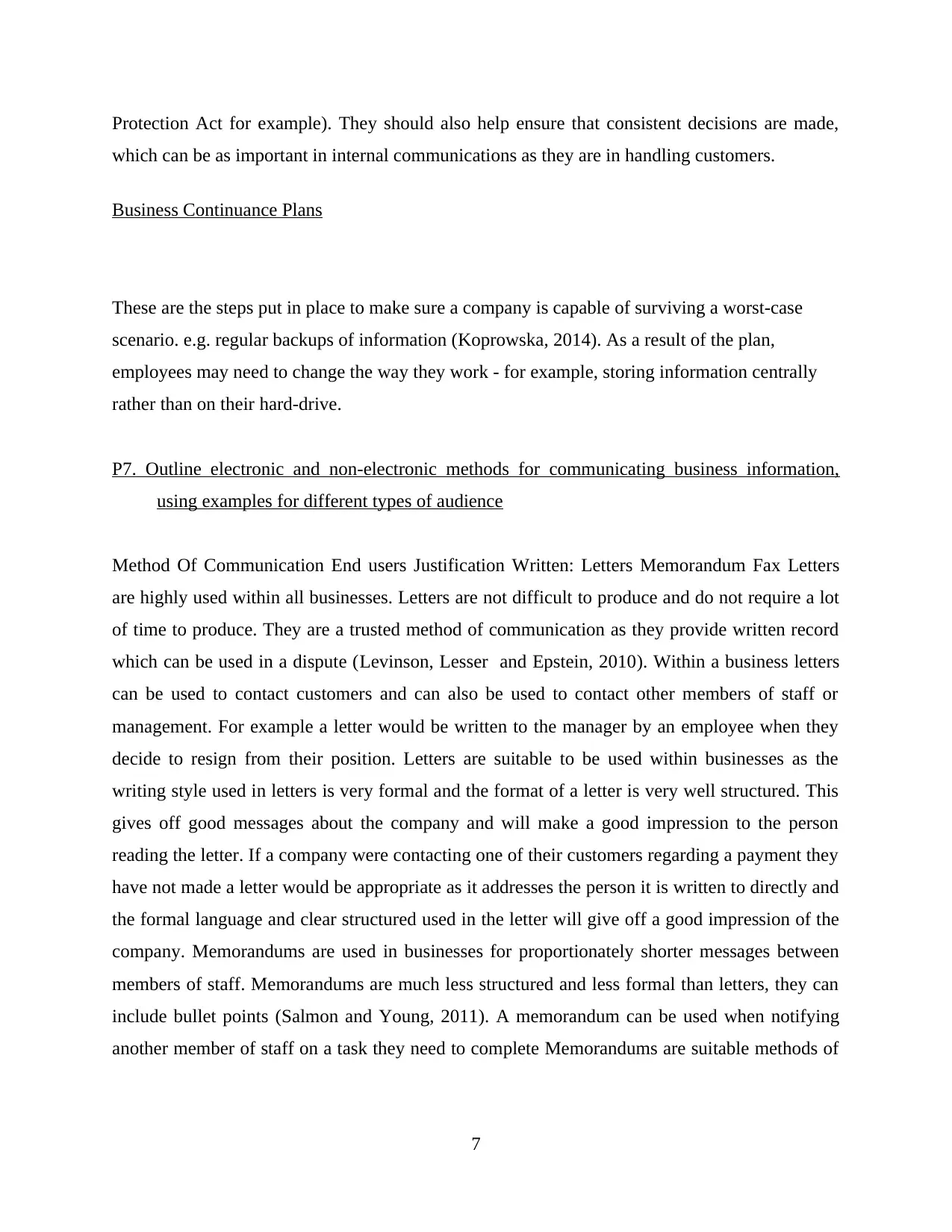
Protection Act for example). They should also help ensure that consistent decisions are made,
which can be as important in internal communications as they are in handling customers.
Business Continuance Plans
These are the steps put in place to make sure a company is capable of surviving a worst-case
scenario. e.g. regular backups of information (Koprowska, 2014). As a result of the plan,
employees may need to change the way they work - for example, storing information centrally
rather than on their hard-drive.
P7. Outline electronic and non-electronic methods for communicating business information,
using examples for different types of audience
Method Of Communication End users Justification Written: Letters Memorandum Fax Letters
are highly used within all businesses. Letters are not difficult to produce and do not require a lot
of time to produce. They are a trusted method of communication as they provide written record
which can be used in a dispute (Levinson, Lesser and Epstein, 2010). Within a business letters
can be used to contact customers and can also be used to contact other members of staff or
management. For example a letter would be written to the manager by an employee when they
decide to resign from their position. Letters are suitable to be used within businesses as the
writing style used in letters is very formal and the format of a letter is very well structured. This
gives off good messages about the company and will make a good impression to the person
reading the letter. If a company were contacting one of their customers regarding a payment they
have not made a letter would be appropriate as it addresses the person it is written to directly and
the formal language and clear structured used in the letter will give off a good impression of the
company. Memorandums are used in businesses for proportionately shorter messages between
members of staff. Memorandums are much less structured and less formal than letters, they can
include bullet points (Salmon and Young, 2011). A memorandum can be used when notifying
another member of staff on a task they need to complete Memorandums are suitable methods of
7
which can be as important in internal communications as they are in handling customers.
Business Continuance Plans
These are the steps put in place to make sure a company is capable of surviving a worst-case
scenario. e.g. regular backups of information (Koprowska, 2014). As a result of the plan,
employees may need to change the way they work - for example, storing information centrally
rather than on their hard-drive.
P7. Outline electronic and non-electronic methods for communicating business information,
using examples for different types of audience
Method Of Communication End users Justification Written: Letters Memorandum Fax Letters
are highly used within all businesses. Letters are not difficult to produce and do not require a lot
of time to produce. They are a trusted method of communication as they provide written record
which can be used in a dispute (Levinson, Lesser and Epstein, 2010). Within a business letters
can be used to contact customers and can also be used to contact other members of staff or
management. For example a letter would be written to the manager by an employee when they
decide to resign from their position. Letters are suitable to be used within businesses as the
writing style used in letters is very formal and the format of a letter is very well structured. This
gives off good messages about the company and will make a good impression to the person
reading the letter. If a company were contacting one of their customers regarding a payment they
have not made a letter would be appropriate as it addresses the person it is written to directly and
the formal language and clear structured used in the letter will give off a good impression of the
company. Memorandums are used in businesses for proportionately shorter messages between
members of staff. Memorandums are much less structured and less formal than letters, they can
include bullet points (Salmon and Young, 2011). A memorandum can be used when notifying
another member of staff on a task they need to complete Memorandums are suitable methods of
7
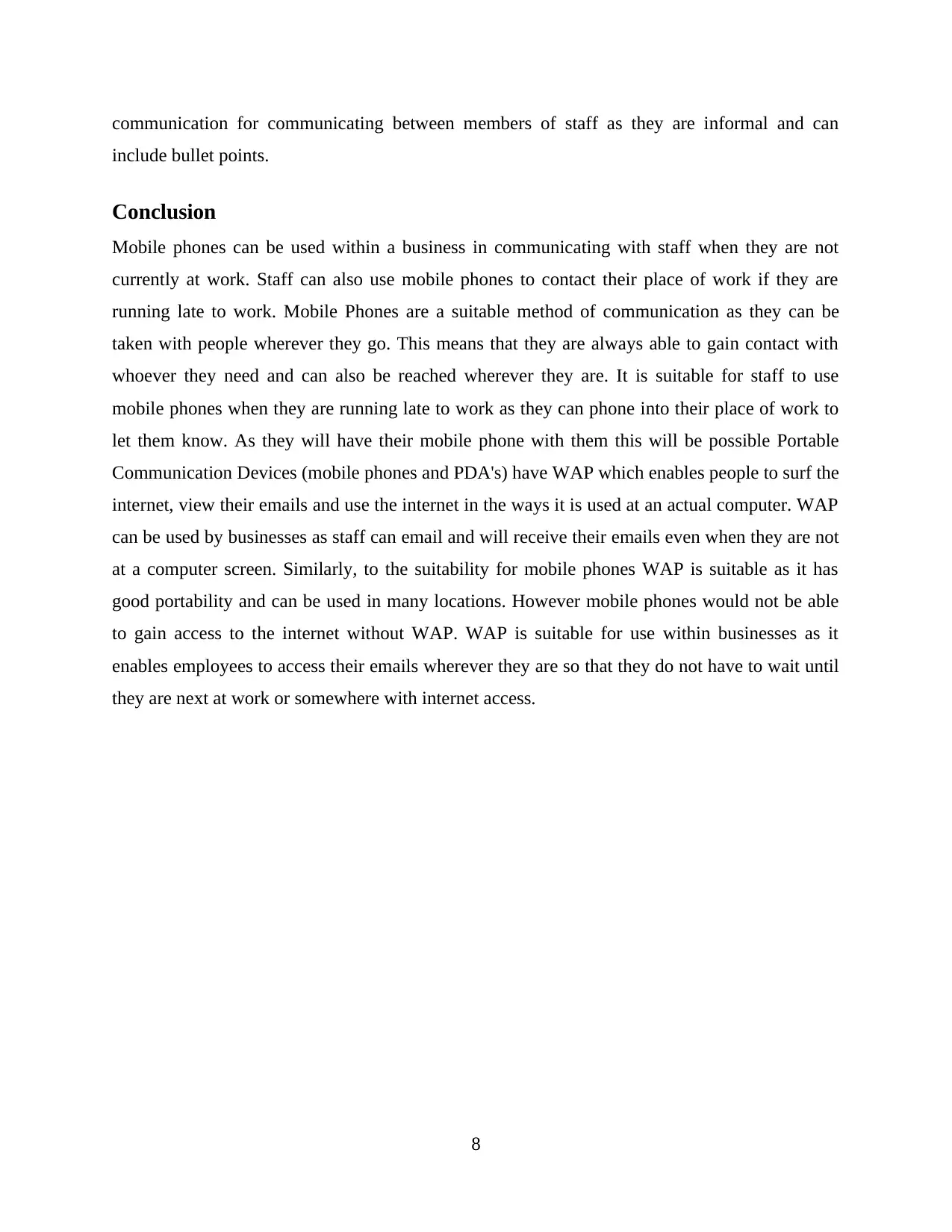
communication for communicating between members of staff as they are informal and can
include bullet points.
Conclusion
Mobile phones can be used within a business in communicating with staff when they are not
currently at work. Staff can also use mobile phones to contact their place of work if they are
running late to work. Mobile Phones are a suitable method of communication as they can be
taken with people wherever they go. This means that they are always able to gain contact with
whoever they need and can also be reached wherever they are. It is suitable for staff to use
mobile phones when they are running late to work as they can phone into their place of work to
let them know. As they will have their mobile phone with them this will be possible Portable
Communication Devices (mobile phones and PDA's) have WAP which enables people to surf the
internet, view their emails and use the internet in the ways it is used at an actual computer. WAP
can be used by businesses as staff can email and will receive their emails even when they are not
at a computer screen. Similarly, to the suitability for mobile phones WAP is suitable as it has
good portability and can be used in many locations. However mobile phones would not be able
to gain access to the internet without WAP. WAP is suitable for use within businesses as it
enables employees to access their emails wherever they are so that they do not have to wait until
they are next at work or somewhere with internet access.
8
include bullet points.
Conclusion
Mobile phones can be used within a business in communicating with staff when they are not
currently at work. Staff can also use mobile phones to contact their place of work if they are
running late to work. Mobile Phones are a suitable method of communication as they can be
taken with people wherever they go. This means that they are always able to gain contact with
whoever they need and can also be reached wherever they are. It is suitable for staff to use
mobile phones when they are running late to work as they can phone into their place of work to
let them know. As they will have their mobile phone with them this will be possible Portable
Communication Devices (mobile phones and PDA's) have WAP which enables people to surf the
internet, view their emails and use the internet in the ways it is used at an actual computer. WAP
can be used by businesses as staff can email and will receive their emails even when they are not
at a computer screen. Similarly, to the suitability for mobile phones WAP is suitable as it has
good portability and can be used in many locations. However mobile phones would not be able
to gain access to the internet without WAP. WAP is suitable for use within businesses as it
enables employees to access their emails wherever they are so that they do not have to wait until
they are next at work or somewhere with internet access.
8
Secure Best Marks with AI Grader
Need help grading? Try our AI Grader for instant feedback on your assignments.
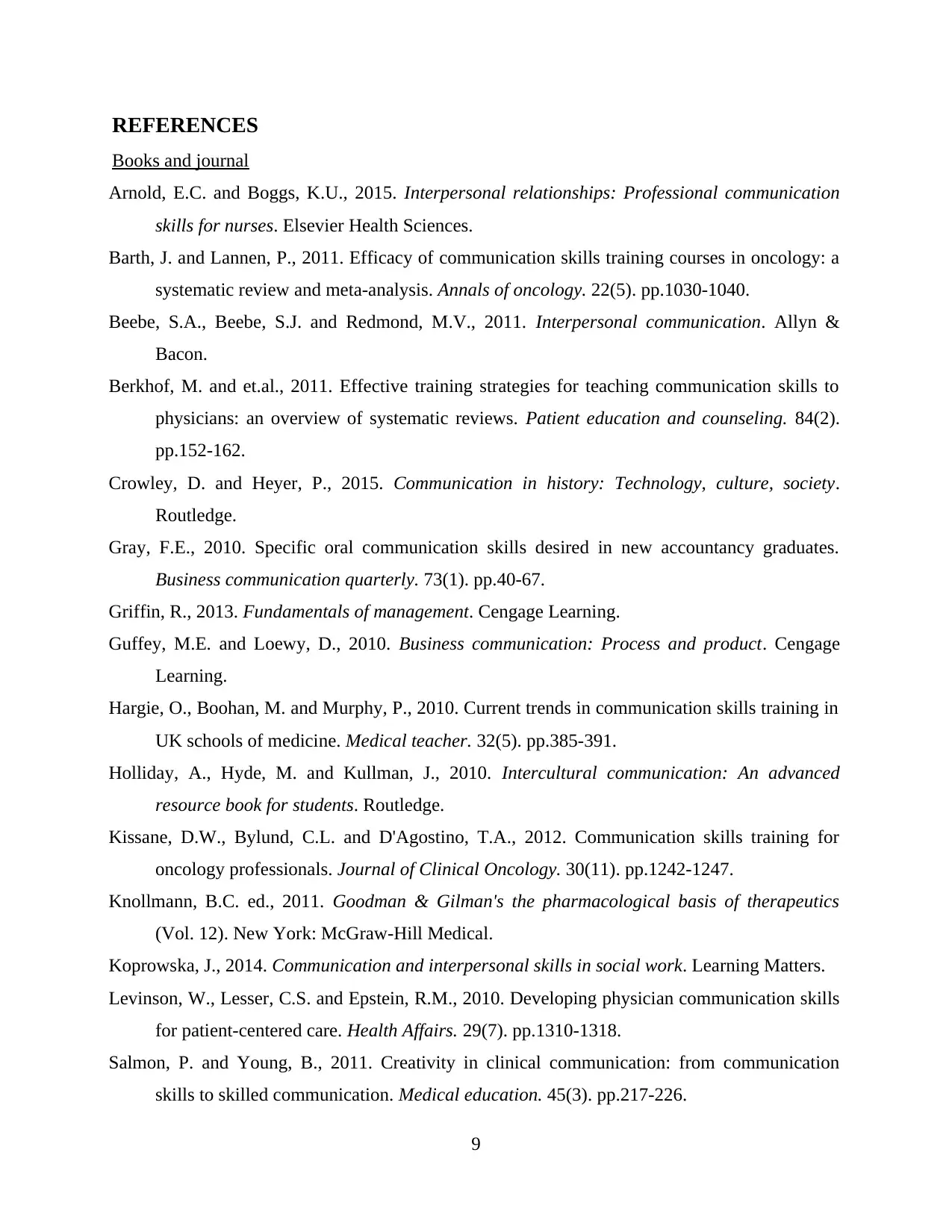
REFERENCES
Books and journal
Arnold, E.C. and Boggs, K.U., 2015. Interpersonal relationships: Professional communication
skills for nurses. Elsevier Health Sciences.
Barth, J. and Lannen, P., 2011. Efficacy of communication skills training courses in oncology: a
systematic review and meta-analysis. Annals of oncology. 22(5). pp.1030-1040.
Beebe, S.A., Beebe, S.J. and Redmond, M.V., 2011. Interpersonal communication. Allyn &
Bacon.
Berkhof, M. and et.al., 2011. Effective training strategies for teaching communication skills to
physicians: an overview of systematic reviews. Patient education and counseling. 84(2).
pp.152-162.
Crowley, D. and Heyer, P., 2015. Communication in history: Technology, culture, society.
Routledge.
Gray, F.E., 2010. Specific oral communication skills desired in new accountancy graduates.
Business communication quarterly. 73(1). pp.40-67.
Griffin, R., 2013. Fundamentals of management. Cengage Learning.
Guffey, M.E. and Loewy, D., 2010. Business communication: Process and product. Cengage
Learning.
Hargie, O., Boohan, M. and Murphy, P., 2010. Current trends in communication skills training in
UK schools of medicine. Medical teacher. 32(5). pp.385-391.
Holliday, A., Hyde, M. and Kullman, J., 2010. Intercultural communication: An advanced
resource book for students. Routledge.
Kissane, D.W., Bylund, C.L. and D'Agostino, T.A., 2012. Communication skills training for
oncology professionals. Journal of Clinical Oncology. 30(11). pp.1242-1247.
Knollmann, B.C. ed., 2011. Goodman & Gilman's the pharmacological basis of therapeutics
(Vol. 12). New York: McGraw-Hill Medical.
Koprowska, J., 2014. Communication and interpersonal skills in social work. Learning Matters.
Levinson, W., Lesser, C.S. and Epstein, R.M., 2010. Developing physician communication skills
for patient-centered care. Health Affairs. 29(7). pp.1310-1318.
Salmon, P. and Young, B., 2011. Creativity in clinical communication: from communication
skills to skilled communication. Medical education. 45(3). pp.217-226.
9
Books and journal
Arnold, E.C. and Boggs, K.U., 2015. Interpersonal relationships: Professional communication
skills for nurses. Elsevier Health Sciences.
Barth, J. and Lannen, P., 2011. Efficacy of communication skills training courses in oncology: a
systematic review and meta-analysis. Annals of oncology. 22(5). pp.1030-1040.
Beebe, S.A., Beebe, S.J. and Redmond, M.V., 2011. Interpersonal communication. Allyn &
Bacon.
Berkhof, M. and et.al., 2011. Effective training strategies for teaching communication skills to
physicians: an overview of systematic reviews. Patient education and counseling. 84(2).
pp.152-162.
Crowley, D. and Heyer, P., 2015. Communication in history: Technology, culture, society.
Routledge.
Gray, F.E., 2010. Specific oral communication skills desired in new accountancy graduates.
Business communication quarterly. 73(1). pp.40-67.
Griffin, R., 2013. Fundamentals of management. Cengage Learning.
Guffey, M.E. and Loewy, D., 2010. Business communication: Process and product. Cengage
Learning.
Hargie, O., Boohan, M. and Murphy, P., 2010. Current trends in communication skills training in
UK schools of medicine. Medical teacher. 32(5). pp.385-391.
Holliday, A., Hyde, M. and Kullman, J., 2010. Intercultural communication: An advanced
resource book for students. Routledge.
Kissane, D.W., Bylund, C.L. and D'Agostino, T.A., 2012. Communication skills training for
oncology professionals. Journal of Clinical Oncology. 30(11). pp.1242-1247.
Knollmann, B.C. ed., 2011. Goodman & Gilman's the pharmacological basis of therapeutics
(Vol. 12). New York: McGraw-Hill Medical.
Koprowska, J., 2014. Communication and interpersonal skills in social work. Learning Matters.
Levinson, W., Lesser, C.S. and Epstein, R.M., 2010. Developing physician communication skills
for patient-centered care. Health Affairs. 29(7). pp.1310-1318.
Salmon, P. and Young, B., 2011. Creativity in clinical communication: from communication
skills to skilled communication. Medical education. 45(3). pp.217-226.
9

Shockley-Zalabak, P., 2011. Fundamentals of organizational communication. Pearson Education.
Ting-Toomey, S. and Chung, L.C., 2012. Understanding intercultural communication. New
York, NY: Oxford University Press.
10
Ting-Toomey, S. and Chung, L.C., 2012. Understanding intercultural communication. New
York, NY: Oxford University Press.
10
1 out of 12
Related Documents
Your All-in-One AI-Powered Toolkit for Academic Success.
+13062052269
info@desklib.com
Available 24*7 on WhatsApp / Email
![[object Object]](/_next/static/media/star-bottom.7253800d.svg)
Unlock your academic potential
© 2024 | Zucol Services PVT LTD | All rights reserved.





